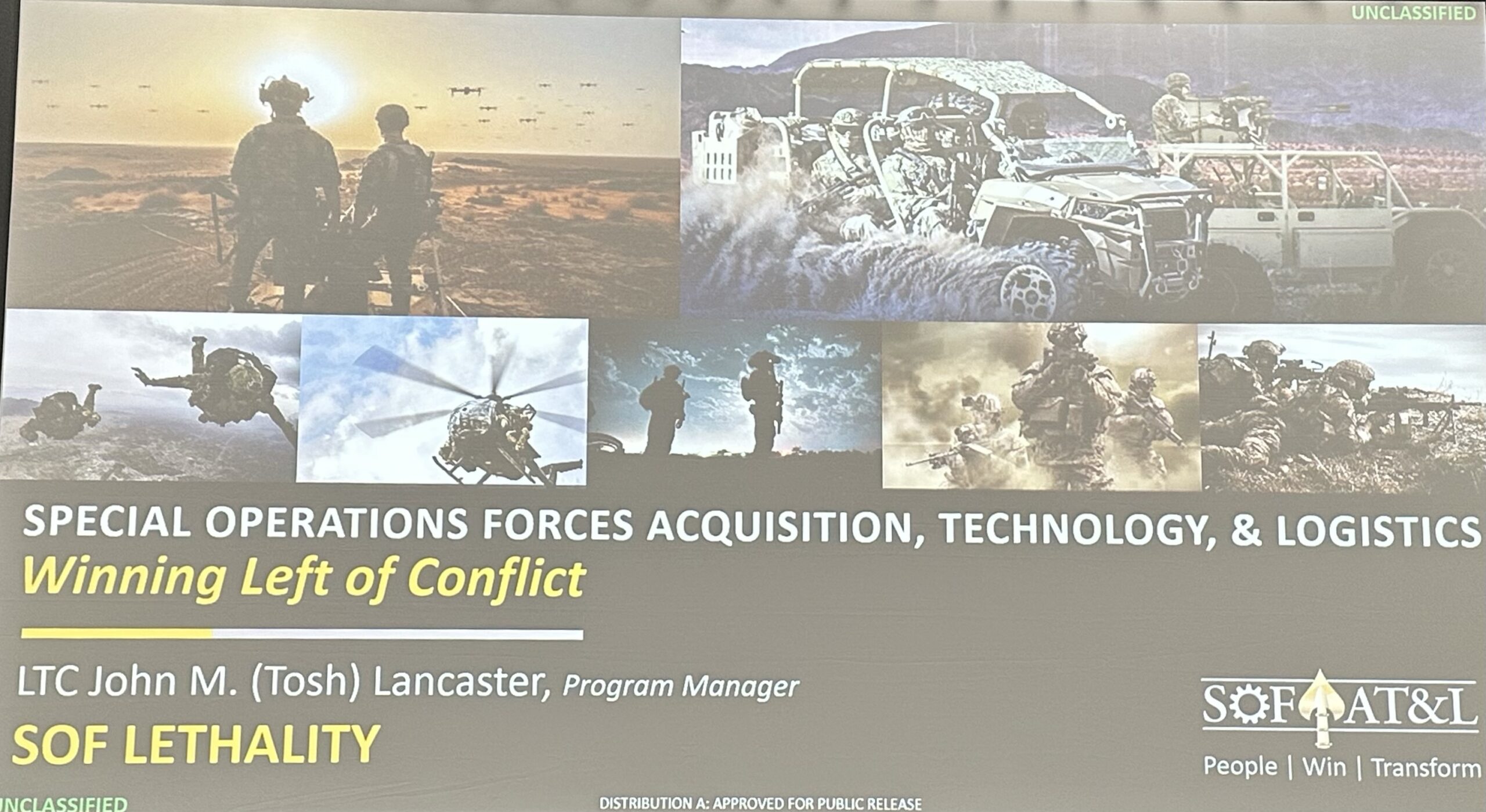
The update to the USSOCOM weapons update is that there’s not much to update. Organized under PEO SOF Warrior, PM Lethality is led by LTC John M “Tosh” Lancaster who conducted a briefing on his portfolio during SOF Week. These are photographs of the slides he used.
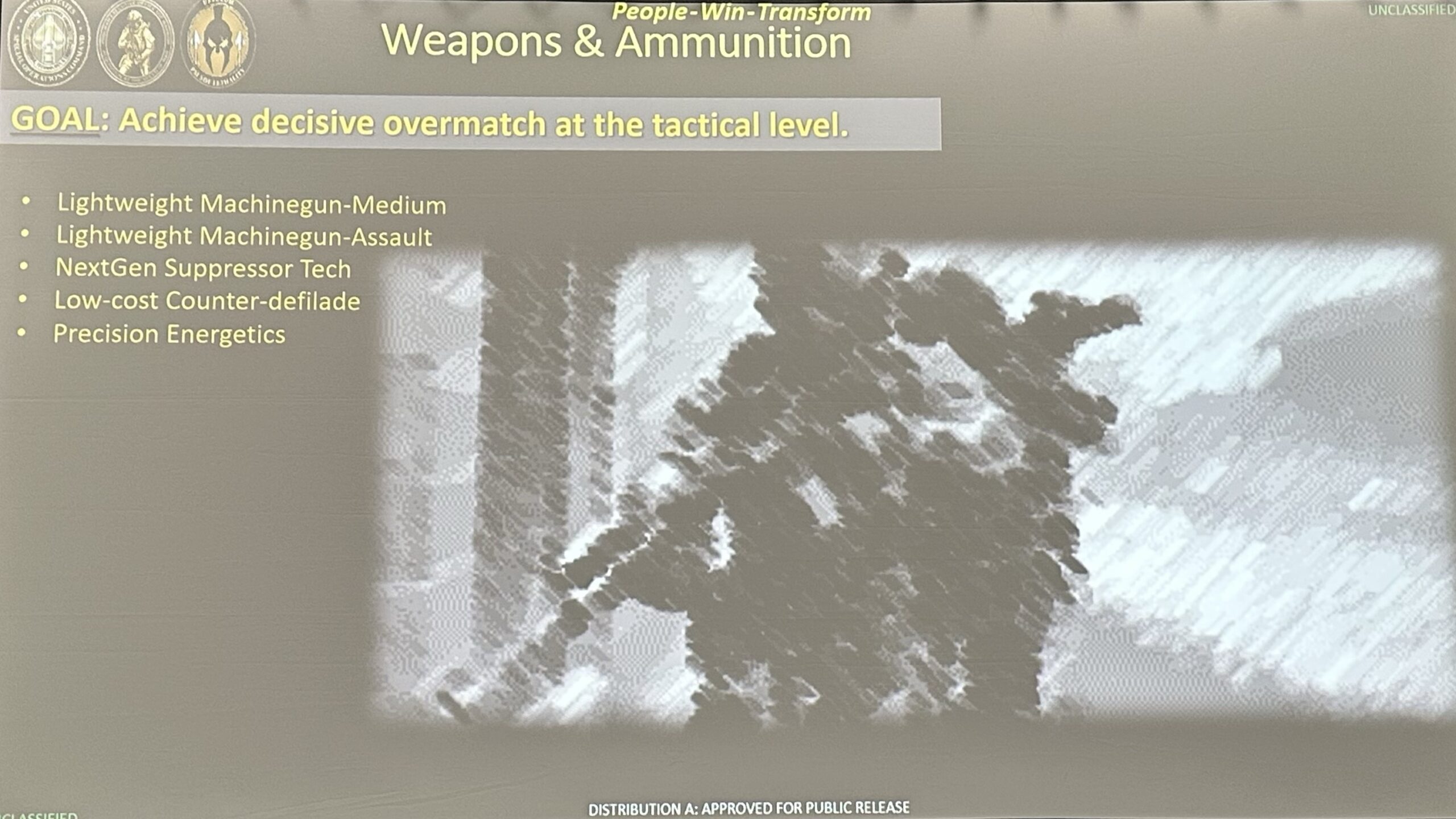
Weapon program continuations from last year include the Lightweight Machinegun-Medium in .338 Norma Mag and Lightweight Machinegun-Assault in 6.5 CM. The LMG-M is underway with fielding anticipated in FY 26, while LMG-A is still in planning. The LMG-M will offer accurate fire at .50 ranges from a weapon lighter than an M240 firing 7.62 NATO. It is in my estimation the greatest single improvement to US small arms in a century.
As part of their service-like acquisition authorities, the command continues to look at Next Gen Suppressor Technologies, low-cost counter-defilade solutions, and precision energetics. For suppressors, they’d like to address the whole gamut: flash, heat, ground disturbance, and sound as well as particulate. On the energetics side, LTC Lancaster mentioned Slap Charges which are primarily used for breaching. This is not to be confused with SLAP (saboted light armor penetrator) ammunition which they are also interested in, particularly in 338 NM.
One interesting disclosure by LTC Lancaster was made during an acknowledgement of the US Army’s 6.8mm Next Generation Squad Weapons program; that US Army Special Operations Command will receive those weapons and ammunition from the Army. What he didn’t say is important. Considering that USASOC has the vast preponderance of SOF ground forces, if the M7 replaces the M4A1s in Army SOF arms rooms, those M4s will once again become SOF unique. Considering the investment, this will lead to a discussion on whether USASOC (and perhaps SOCOM writ large) wants to continue with the M4 or look for a new weapon and possibly caliber. They could reject 5.56mm NATO completely and fully adopt the NGSW weapon and ammunition, or look for a new lightweight carbine in some flavor of 5.56 or another intermediate cartridge (sorry fanboys, 6 ARC isn’t the answer, but that’s another discussion).
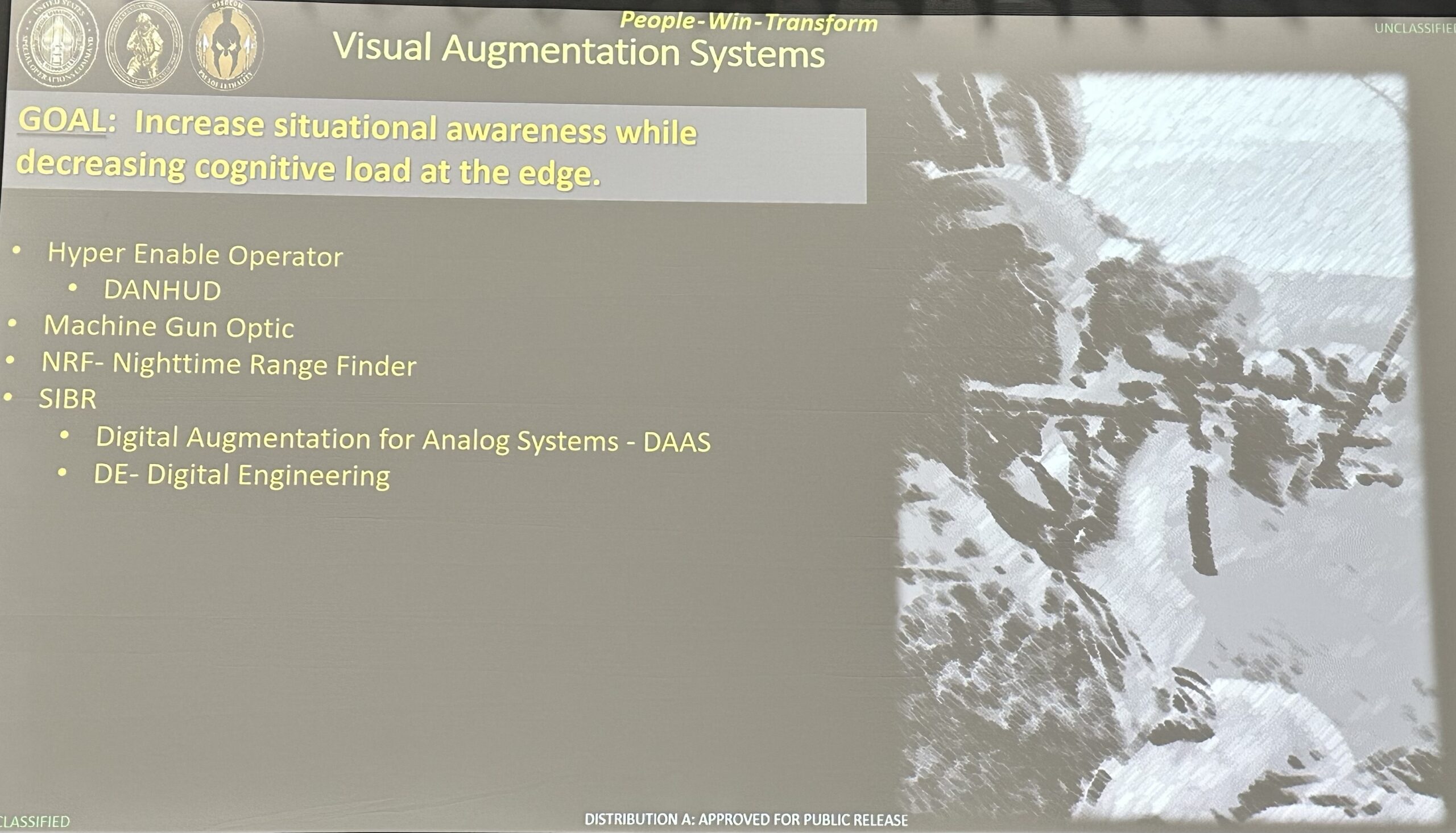
On the Visual Augmentation System or VAS front, LTC Lancaster explained that every 18 to 24 months he has an opportunity to transition a promising technology from the work being done by the Joint Acquisition Task Force in pursuit of the Hyper Enabled Operator objective, which is itself an off-shoot of the Tactical Assault Light Operator Suit (TALOS) or so-called “Iron Man” program.
DANHUD is just such a project. The Day And Night Heads Up Display will integrate with ATAK and head protection systems to project relevant data to the eyes. LTC Lancaster wants to get the operator’s eyes off the screen and back up into the fight. While the Army continues to work on the Integrated Visual Augmentation System (IVAS), DANHUD is moving at a much faster pace and is more focused on immediate operator needs.
They are also seeking a new Machine Gun Optic for use with LMG-M to be fielded in FY 26 along with the weapon.
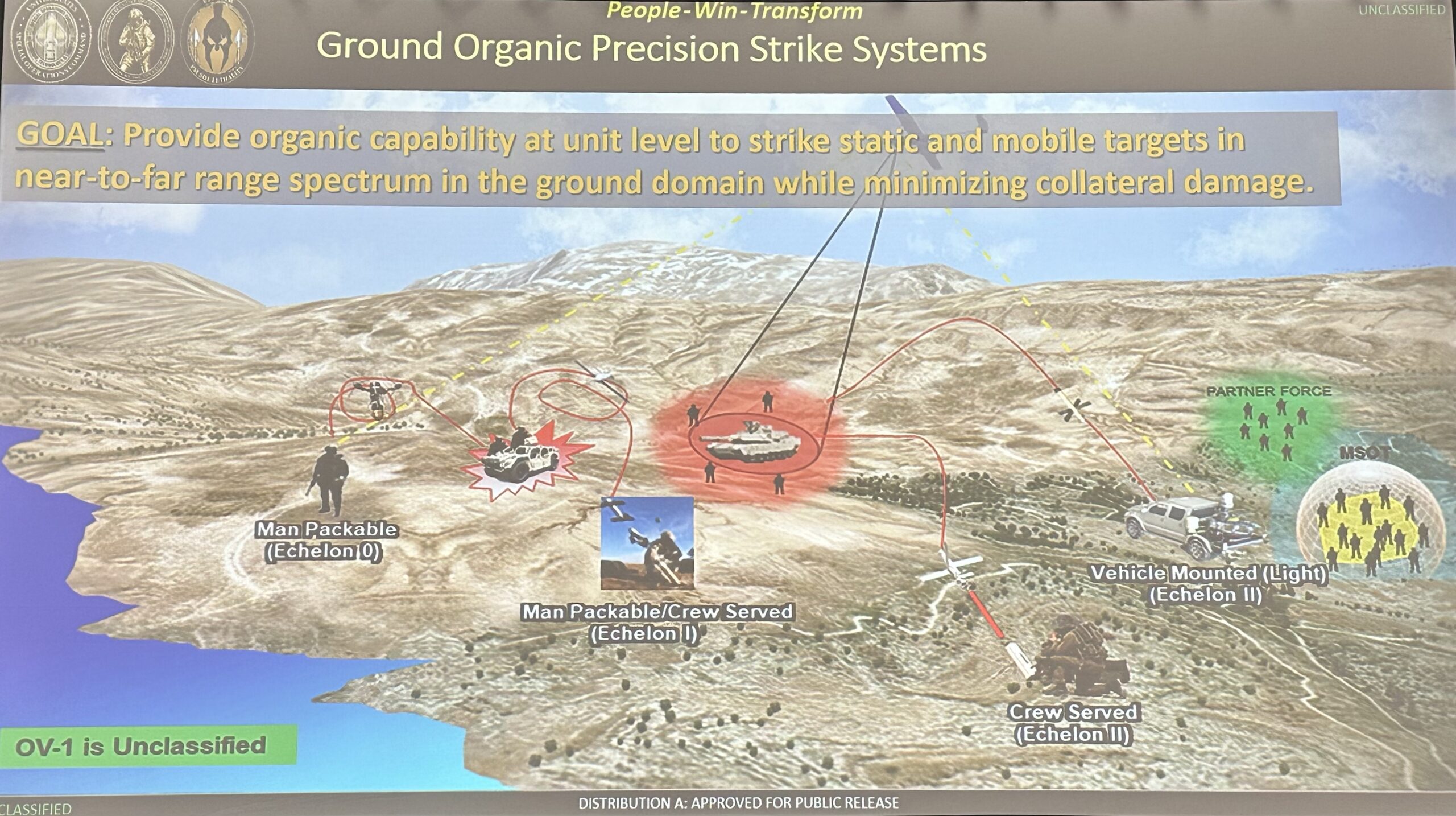
Ground Organic Precision Strike System is also a carry over. Envisioned as a system of different sized strike capabilities, GOPSS offers the ground SOF element with its own precision fires.
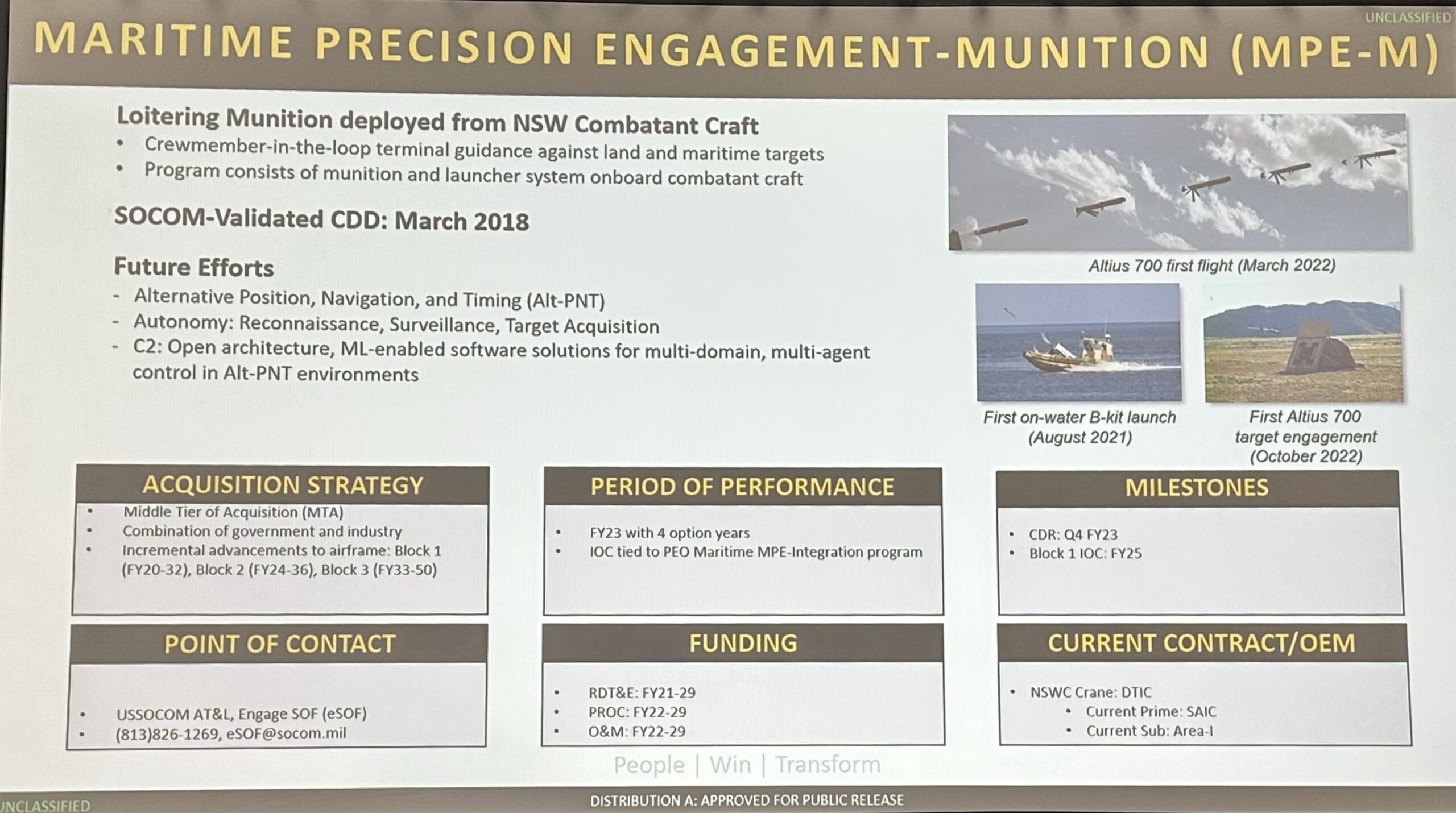
Maritime Precision Engagement-Munition is managed by Program Management Office–Naval Special Warfare, also inder PEO SOF Warrior. As a surface-based analog to GOPPS, MPE-M delivers a Javelin-sized warhead from a loitering munition launched from a Naval Special Warfare surface craft. It features operator-in-the-loop and can be used against land and surface targets. Future improvements include non-kinetic payloads and Alt-PNT guidance modalities.
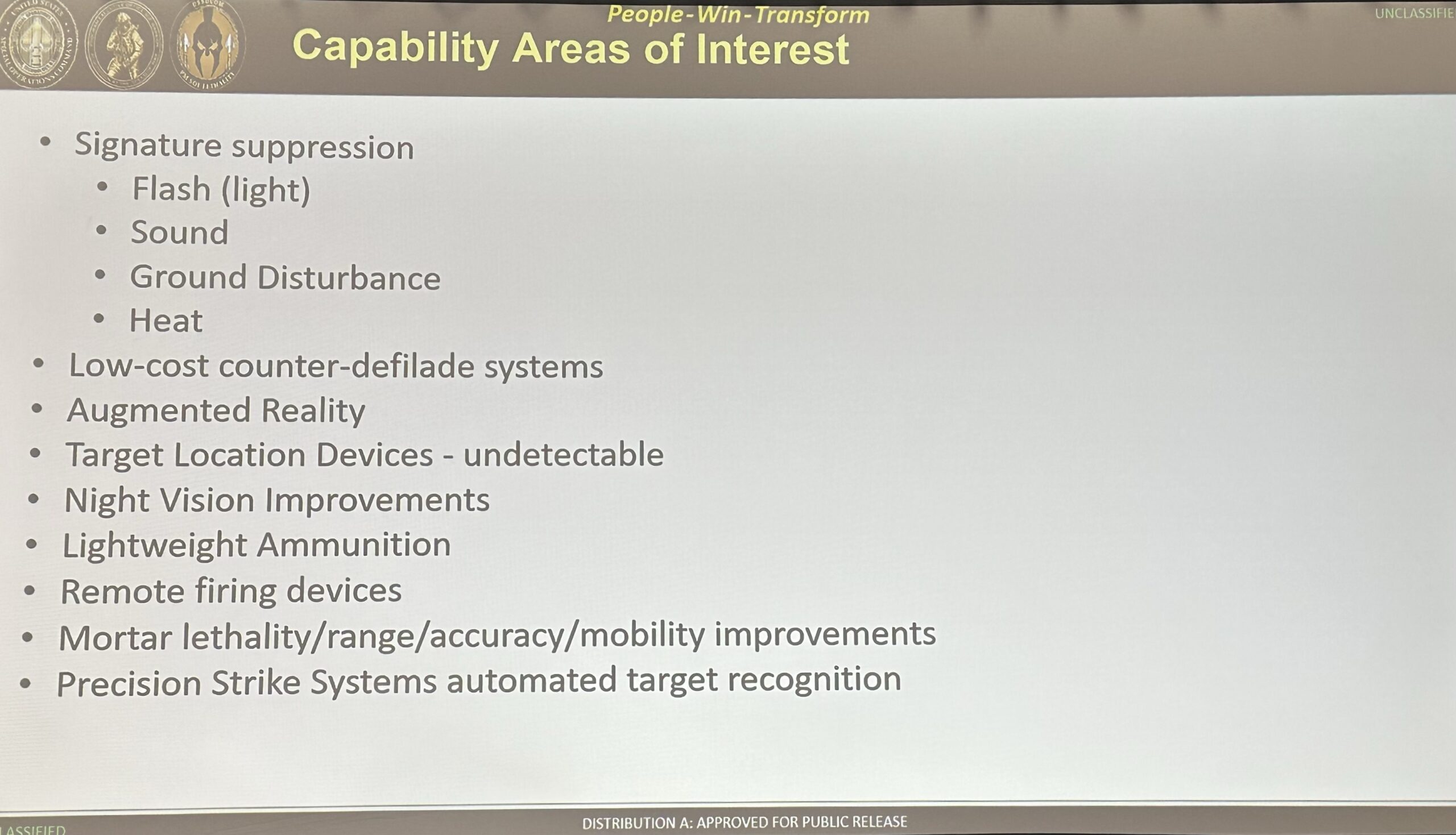
Above is a laundry list of capability enhancements USSOCOM is interested in, regardless of whether there is a formal program. Almost all of these are technology insertions into existing capabilities rather than completely new systems. However, the announcement for the Mortar Fire Control Device requirement should be available through SOFWERX soon.
On a final note, lethal droids are coming to SOF. Just as unmanned aerial systems like Switchblade have been weaponized, expect similar results for ground robots. For example, throw bots that explode and weaponized unmanned ground systems. Like with aerial systems, an operator will remain in the loop for final weapon release authority.


SSD,
On the point on NGSW, couldn’t their availability to USASOC mirror the M9/M17, where they are present in the arms rooms by way of Big Army but USASOC still chooses the Mk27 (or in this case M4A1 via unit funds)? Did LTC Lancaster say anything that would lead you to believe USASOC would use the NGSW systems?
Additionally, I’m not really following on how the presence of the M7 for USASOC makes the M4 SOF specific, since the M7 would be at least present to supplement the M4 in that circumstance? Portions of the USMC and Army non-CCF will retain M4/M4A1 for some time, correct?
Is SOCOM still looking into a 6.5CM version of the XM250 for USASOC?
A final question, was there any mention/update on MRGG?
Thanks for the reporting SSD!
They are being fielded to USASOC. If they become rack guns via the MTOE (and they are across all of the Army’s close combat forces), they will displace the M4A1s currently provided by the Army. If USASOC wishes to keep the M4s, that is now a SOF problem, meaning funding via MFP-11. Those guns will compete for resources like airplanes (SOCOM has its own sizable Air Force), radios, vehicles, etc. That’s going to force a discussion on whether it’s the right investment path forward.
MRGG remains in limbo, at least publicly. They aren’t even talking about it. A decision was made on MRGG-S but still no contract. MRGG-A is supposed to happen (yet again) in the future. Supposedly, SOCOM finally has its act together on 6.5 CM ammo which will help but adopting two different rifles for A and S variants seems pretty foolish.
The Glocks within USASOC will go away before long. It’s hard to justify to paying for a gun when you get one that does exactly the same thing for free. I expect 6.5 CM to eventually go away as well with the Army’s adoption of 6.8.
In the end, it’s a balance of capability and cost. SOCOM has a limited budget and with most of its funding going to aviation, they have to decide where to spend what is left. If they are getting capability for free, that will do it.
It’s a mess. If they can get the M7 and M250 it’s going to be hard to justify any of the 6.5 guns. It could be an interesting few years, honestly wonder if there won’t be a push towards a more tailored PDW replacement or update for the M4.
It seems to me that the M7 makes the MRGG-A an obsolete requirement.
Likewise something like the old Sig CSASS MCX-M which is basically the M7 with a longer barrel and sniper stock would allow for greater parts commonality and easier training in regards to the MRGG-S.
But what I’m really curious about is the future of the FN LIC 6.5mm carbine.
The reality of MRGG is that it an NSW requirement. The numbers are low. Considering they are on their second mulligan, it’s been a whole lot of movement for very little effect.
Thank you for the reply. Given what we know now, what are your thoughts on the FN 6.5 LICC in the big picture?
Seems like what we have seen so far during the past year of the Ukraine War, that the new M-7 really is not suitable for CQB trench warfare or 0 to 300 meter engagements. The M-7 was developed to address a desert war where long engagements to hit targets was needed due to the range limitations of the M-4/A1s and other squad weapons. Big Army needs to invest in an updated M-4/A1s to reflect what we have learned from the Ukraine War. Big Army should have upgraded all M-4/A1s with 16 in barrels with nitrite coating and BCGs with that new DLC we read about the Army inventing just a few years ago here on Soldier Systems. Was that DLC ever implemented on any weapons system in the Army or other branches? Barrel and coating technologies have come a long way since the start of the GWOT. M-4/A1s barrels several years ago were allowed to have a 5 MOA group tolerance at 100 yds as opposed to the old 2.5 MOA tolerance prior. Just put 1 M-7 per squad to beef up its range capabilities is really what is needed and not every rifleman with an M-7.
What I laugh at is the damned if you do, damned if you don’t, situation people put the Army in. You get the guys who complain that the military never prepares for the next war. They do it this time and here people are, complaining that they’re preparing for the next war.
If we fight with Russia, it won’t be in trenches.
The U.S. Army does not really know what it really wants for the next war. It could not even get a good camo uniform for soldiers in the desert environment for the first half of the GWOT. There are always options that the Army does not take to improve a soldiers combat effectiveness, but they do not do it. Big weapon systems take priority over the average infantryman. I guess if we can fight with a .30 rifle in the jungles of the Pacific in WWII, it is perfect for the next war we get into, but there was a little jungle war in Vietnam that changed that. We will probably have nothing ready for the next war in total honesty. Just look at history of past wars to see that.
We dug a lot of holes in the ground when I was in the Fulda Gap in West Germany, what do you call that? People just forget that because of the GWOT. I really do not see any deserts in Ukraine or Europe for long range engagements for the M-7 to be practical for an infantry unit. Modern trench and urban warfare might be the new norm and not the WWI trench warfare. What we are seeing in Ukraine will probably be the future of warfare. A smaller country defending against a larger countries invasion. What happened in the early 2000’s to Georgia was just a testing ground for what has happened to Ukraine since prior to 2014.
Once again, they are taking steps right now to plan for the future and they know exactly what they want. I am amazed they are actually doing it.
In case you completely missed it, and by your comment it appears you did, Next Generation Squad Weapons is a major investment in small arms for the Infantryman. The ENVG-B is a major investment for the Infantryman, as is its follow-on, IVAS (if it ever works). The upcoming Precision Grenadier System and .338 NM machine Gun are both investments for the Infantry. Already fielded is the M3A1 Carl Gustaf, along with work on new ammunition. Those were procured for the Infantry.
Your tunnel vision on ranges ignores Northern Europe, the African Veldt, the Steppes of Russia, Mongolia, and Central
China Plain as well as a multitude of islands scattered across the South Pacific.
Based on your argument, I suppose you see no need for a belt fed machine gun (in any caliber above 5.56, including the M2) because of your fixation on ranges up to 300m? No need, right?
You are allowed your opinion and I am allowed my opinion of how the Army has screwed up things over the past 20 years. The article above is about SOCOM and not regular infantry units. SOCOM does what it wants, gets what it wants, and decides to use it or not. Regular infantry units do not get a say when the Army tells them to switch from M-4s to M-7s. M-7s have not even been fully field for an infantry unit to test yet.
I guess SSD has failed to see what really has been going on in Ukraine with small arms over the past year, which the Army should be looking at more closely than the past 20 years of the GWOT using small arms at the squad level to fight the Taliban and ISIS. We will need much more ammunition than was planned for during a conflict with a peer to peer adversary is the big take away.
I do not have tunnel vision, but maybe be SSD has drank the cool aid the Army is pushing right now with the M-7 and overmatch ideas from the GWOT. We have seen billions wasted on useless camo uniforms and other promised things for the infantry over the years. The Army’s promise of lightening the loads that infantryman carry into combat, which has not materialize in sufficient amounts to reduce the burden of daily combat operations. That is why we have a new physical fitness requirements to reduce the pain and suffering of the heavy loads an infantryman had to carry during the GWOT and currently.
I have not made any argument against crew served weapons systems or other automatic firearms used at the squad level, such as the M-60, M-249 SAW, M-240s, M-2, or other systems. If, you had read anything that I wrote you would be able to determine that. My focus was on the M-7 for every infantryman and its burden to their operations. If, you read what I wrote you would already know I was stationed in Europe in the Fulda Gap and I was not a cook either.
I would like to ask all those soldiers that fought the GWOT if they would want a heavier combat rifle, less ammo, and still be told to be in a full plate carrier with all the other equipment they had to carry daily for hours on end on patrol and fighting the Taliban and ISIS. They would probably say no to that, but soldiers don’t have a choice. Burden soldiers with more weight of a heavier weapon and less ammo is not the answer. 20 rds of 6.8 vs 30 rds of 7.62×39 or 30 rds of 5.8×42 is not good. Most modern combat doctrine states, the one with the most ammo wins the fight. Sure that new weapons sight will be fantastic on the M-7, but it will be useless in jungles of the Pacific, which has been some of the focus for our military in the past few years. If, we are fighting in China or Mongolia then something has gone very wrong.
“Overmatch for the GWOT”. Hate to burst your bubble, but the terrorists were using Russian small arms. We’ve had an overmatch issue vis-a-vis ComBloc aka Russian small arms since the demise of .30-06 in the US inventory.
If you haven’t made an argument against legacy crew served weapons due to their weight-to-effect ratio then your argument against a new rifle lacks merit. Those are ok, but a rifle that outperforms them is is no valid argument.
As far as weight, we won World War Two with the M1 Garand firing .30-06 ammo. Those guys weighed in at about 140 lbs. Our troops will be fine. They are larger and healthier than an Army that had just suffered through the Great Depression.
I think those terrorist were using 7.62×54, similar to our .30-06, on belt feed PKM and sniper rifles was the problem for our soldiers fighting the Taliban and ISIS. AKs just did not have that extended range. The term overmatch was used during the GWOT to promote the development of a new rifle for the Army by Jim Schatz and others, which SSD has posted numerous articles about over the past 10 years, such as the one below.
Jim Schatz – A Path To Overmatch – Next Generation Individual Weapon System Redux
https://soldiersystems.net/2023/01/05/jim-schatz-a-path-to-overmatch-next-generation-individual-weapon-system-redux
My comments about the M-7 weight and lack of ammunition capacity has merits. WWII soldiers did not have the weight that is carried by modern soldiers during and after GWOT for over 20 years, which is 30 lbs basic load carry without the weapon system and more than 60 lbs at times. Weight is everything that effects a soldiers mobility. Even in the The Baldwin Files by Terry Baldwin here on SSD, there has been discussion about overload as problem for soldiers as part of his The Fighting Load series. The conundrum is mobility vs level of protection for the infantryman, which was not used much during and after GWOT.
The Baldwin Files – The Fighting Load Continuum
https://soldiersystems.net/2019/01/12/the-baldwin-files-the-fighting-load-continuum
https://soldiersystems.net/2019/05/04/the-baldwin-files-the-fighting-load-continuum-part-ii
https://soldiersystems.net/2019/06/27/the-baldwin-files-the-fighting-load-continuum-part-3
https://soldiersystems.net/2021/01/30/the-baldwin-files-the-fighting-load-continuum-part-4
Yes, Overmatch is a term used to describe the increase in range and lethality of threat weapons over US weapons. It’s not a new concept and something that has been discussed for decades. Go ask the boomer generation about dropping the M14 for the M16.
Yep, the Soldier’s load will always be an issue. If you care more about load than lethality, give everyone an SMG.
You can complain all day about the US Army’s decision but I suggest you go through the stages of grief and come to acceptance. This is happening. The alternative is nothing happening and spending another 30 years with weapons and ammunition which are at the limits of development. There is no alternate path at this point.
Steve Holland from the 5th SFG talks about the HK rifle with a 16 in barrel and 6.8×43 cartridge in the video below on the forgotten history of the rifle we should have had for the infantry more than 10 years ago that was junked.
Special 100th Tactical Tuesday – Tactical Rifleman
https://www.youtube.com/watch?v=TsNwXVkFSmM
J,
You have some good sources to support your comments. I have known Steve Holland for over 30 years. He is a true “gun/ammo subject matter expert.” I would not ever question his opinions in those areas. However, in terms of load carriage, I think you missed a couple of points I made in my series.
One, no one has ever made a truly scientifically valid assessment of how much ammunition a soldier actually needs in combat – ever. For no objective reason, we went from 88 rounds as a basic load for the M1 Garand, to 100 rounds (five 20 round mags) for the M14, 140 for the M16A1 with seven 20 round mags, then 210 for the M16A1 with seven 30 round magazines. I presume that the M7 will be 7x 25 round magazines for 175. That is still a very comfortable number.
Never mind Vietnam where a “basic load” was routinely over 300 rounds loaded in 20 round magazines. That was driven by a lack of confidence in the logistics systems and on wasteful full auto “spray and pray” tactics.
The point that is most important is that more ammo does NOT equal more combat effectiveness. More experienced and confident troops tend to carry less ammo not more. The choices are not binary. A soldier’s load, mobility, and lethality are constantly assessed and balanced.
Given the fire control system, and the new platform/ammos characteristics, I expect the M7 – with a trained operator on the trigger – will deliver lethal effects on targets better and faster than legacy systems – within and beyond 300 meters. I also expect that the M7 – like the M4 – will get lighter and more compact over time.
Like SSD, I am encouraged that the Army is taking this bold step now. And, I think it is going to pay off for the “close combat force” once we get through the messy birthing stage. Good discussion!
TLB
Steve Holland from the 5th SFG talks about the HK rifle with a 16 in barrel and 6.8×43 cartridge in the video below on the forgotten history of the rifle we should have had for the infantry.
Special 100th Tactical Tuesday – Tactical Rifleman
https://www.youtube.com/watch?v=TsNwXVkFSmM
Bad timing. I remember discussions within SOCOM about adoption, but in end, the command didn’t really want to adopt a new cartridge at the time. A lot of guys on the operational side were all for it, while others wanted their dream cartridge. With no unified voice, bean counters made the final decision. Internal squabbling ultimately killed it.
Hmmm P2 vs P11 funding – sure use big army P2 purchase dollars to equip SOF warfighter & P11 keep close to Martian viable SOF peculiar programs